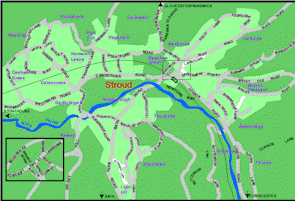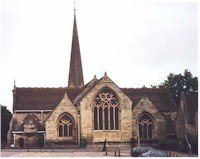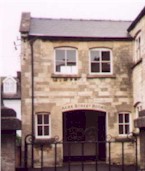Stroud Genealogy
Notes on Stroud which will hopefully assist family historians in adding depth to the basic births, baptism, marriage and death records of their ancestors. The notes are taken from odd fragments of information gleaned over the years, and have no specific format. Much of the information is second or even third hand, and should therefore be checked against the original record. Information is added regularly.
Notes on errors, omissions and additions are always welcomed.
Refer to Stroud Area for other parishes and villages in the area
 Stroud is approximately ten miles south of Gloucester.
Stroud is approximately ten miles south of Gloucester.
Stroud did not become a separate parish until 1360. Prior to that it was part of the
parish of Bisley.
In the nineteenth century it was the centre of the clothing trade
The Great Western Railway line from Swindon to Gloucester, via Stroud, opened in 1845.
Larger size map available - Click here or on map.
The Stroud Bank
Formed on 1 January 1779, with a capital of £10,000. Principal shareholders
were:-
James DALLAWAY, a clothier in Brimscombe
John HOLLINGS (died 1799), a shopkeeper. He withdrew from the Stroud Bank
partnership in 1798.
Joseph WATHEN, a Justice of the Peace and clothier, with mills at Rooksmoor and Stroud. He
lived at New House, Thrupp.
James WINCHCOMBE (died 1780). Rodborough clothier and dyer, owned Ham Mill, Stroud. In
1778 appointed Deputy Lieutenant of Gloucestershire.
All four men were also shareholders in the the
Stroudwater Canal.
Population.
A note in the St. Laurence church, Stroud, register, after the 1802 baptisms,
records: "By an accurate enumeration made in April 1801 the population of the parish
appears to be as follows: Males 2602, females 2820, total 5422. (The greater number of
females is owing to a destructive war, of which this was the 8th year ). Families 1355;
inhabited houses 1033, uninhabited 15. Traders or manufacturers 3711; Agriculturers 240;
Independents, aged and infants 1465.
About 1200 more than Bisley, and about 1600 more than Painswick.
In the year 1784 by a calculation, the number of inhabitants was supposed to be 4,542. The
subsequent increase was occasioned by the introduction of cloth making".
In the census of 1821 the parish had 7,097 inhabitants.
Population in 1961 was 17,461
 St. Laurence Church, Front entrance from the Shambles, side via
Church St. The Parish Church for Stroud. Originating from a chapel
mentioned in the ancient Composition of 1304, the old church was demolished in 1866, the
last service being held there on Sunday, July 8th, 1866.
St. Laurence Church, Front entrance from the Shambles, side via
Church St. The Parish Church for Stroud. Originating from a chapel
mentioned in the ancient Composition of 1304, the old church was demolished in 1866, the
last service being held there on Sunday, July 8th, 1866. Monumental Inscriptions of Old Church
A new church, incorporating the medieval tower and spire, was built on the same site. The architects were Wilson and Willcox of London and Bath. During the construction of the church the congregation had met in a tabernacle on Slad Rd., so it was was with some relief that the new church was consecrated by the Bishop of Gloucester 4th August 1868.
Parish registers 1624-1976 are lodged with the Gloucestershire Record Office.
Holy Trinity Church, junction of Trinity Rd. and Horns Rd.
Originally opened in 1839, as a chapel of ease to the parish church of St. Laurence. Parish registers 1879-1973 are lodged with the Gloucestershire Record Office.
St. Alban Mission Church, Parliament St., Stroud Hill.
Consecrated 1916. Anglican Methodist shared church 1999.
Parish registers 1916-1960 are lodged with the Gloucestershire Record Office.
Our Lady of the Immaculate Conception Roman Catholic Church, Beeches Green.
Built 1857/8 on land purchased by Emily Sandys.
Baptist Chapel, John St.
Built 1823, still in use 1999. Records for the period 1823-1964 are lodged with the Gloucestershire Records Office (lodged 1994).
Christadelphian Meeting Room, Lansdown.
Situated next to the Spiritualist Church.
Congregational Chapel, Bedford Street.
Originally called "Union Chapel", built in 1835-7. The name was changed when the street it which it is situated was named Bedford Street rather than the expected name of Union St. Architect Charles Baker, who was also responsible for the nearby Subscription Rooms. Still in use 1999.
Methodist Chapel, Acre St., Stroud Hill
Oldest surviving octagonal methodist chapel, built 1763, enlarged 1796. Locally known as the 'Round House'. John WESLEY preached there between 1765 and 1790. In use by the Salvation Army in 1905, still in use by them 1999.
On the left hand side of the Shambles, as you approach St. Laurence Church, is a plaque which reads :-
On this site the Revd. John WESLEY 1703-1791 preached from a butchers block 26 June 1742. "The best of all is God is with us".
The Methodists congregation now share St. Alban's Church.
Old Chapel, Chapel Street.
Built between 1704 and 1711. Originally Presbyterian, but also used by Independents, and by 1811 had become Congregational. Between 1813 and 1823 the chapel was enlarged and a school-room built. Remained open until 1970, when its congregation joined that of the Bedford St. Chapel. Demolished 1977. Stroud Museum have the benefaction boards and some of the monuments. Monumental Inscriptions
 Plymouth Brethren Meeting Room, Acre St.
Plymouth Brethren Meeting Room, Acre St.
Founded 1852. In existence 1999, as the Acre Street Rooms, Gospel Hall.
Larger image of Acre Street Meeting Room.
Primitive Methodist Chapel, Parliament St.
Built 1836. Closed as a chapel in the 1950's. In use as Playhouse Theatre in 1999.
Salvation Army Barracks/Citadel, Acre St.
Formerly Methodist Chapel. In use by the Salvation Army in 1905, still used by them 1999.
Spiritualist Church, Lansdown.
Situated between the Library and the Christadelphian Meeting Room.
Stroud Cemetery.
Situated upon the southern slope of Stroud hill, nearly opposite to the union workhouse, but on the lower side of the new Bisley road. It lies between that road on the north, and the way leading through the fields from Whitehall to the valley of Horns on the south.
In the year 1854, the several burial grounds in Stroud having become insufficient in size and dangerous to health, an Order was issued by the Secretary of State in October of that year for closing them, (with certain exceptional regulations), from the 1st of September, 1855.
A Burial Board, was set up, consisting of four Orthodox and four Nonconformists, tasked with the provision of burial facilities. The Board purchased six acres of land, part of a wood called "The Conygear", and erected two chapels with a spire, and an entrance lodge.
In 1867 another part of the Conygear was bought, consisting of a cottage and three acres and thirty-three perches of land.
The chapel and about three acres of the Cemetery which had been set apart for the use of the Episcopalians of the parish, were consecrated by Dr. Baring, Bishop of Gloucester on September 1st, 1856. On the 4th of September William Lewis, a pauper from the Union Workhouse, was the first to be interred in the new burial ground.
From that time to the end of 1869, a period of thirteen years and four months, the number of burials was 1,500, being an average of 115 per annum. Of this number two-thirds were buried in the consecrated ground, and one-third, (including fifty-four Roman Catholics) in the unconsecrated ground.
At the same time the Cemetery contained 130 tombs or other monumental memorials.
Listing of some of these
memorials.
Further Information.
Gloucestershire Notes and Queries. Volume 1. Edited by the Rev. Beaver H. Blacker, M.A., and published in 1881.
Gloucestershire Notes and Queries. Volume VI. 1894-5. Edited by W.P.W. Phillimore, M.A., B.C.L. Published 1896.
Notes and Recollections of Stroud. By Paul Hawkins Fisher.Originally published in 1891. Republished by Alan Sutton 1975. ISBN 0 904387 06 2
Nonconformist Chapels and Meeting-Houses, Gloucestershire. Royal Commission on Historical Monuments of England. 1986.ISBN 0 11 300008 1
The Stroudwater Canal. by Michael Handford. Published in 1979 by Alan Sutton Publishing Ltd. ISBN 0 904387 30 5.
Towns and Villages of England: Stroud, by Philip Walmsley. Published in 1994 by Alan Sutton Publishing Ltd. ISBN 0 7509 0589 1
Parish Records. Gloucestershire Records Office.
